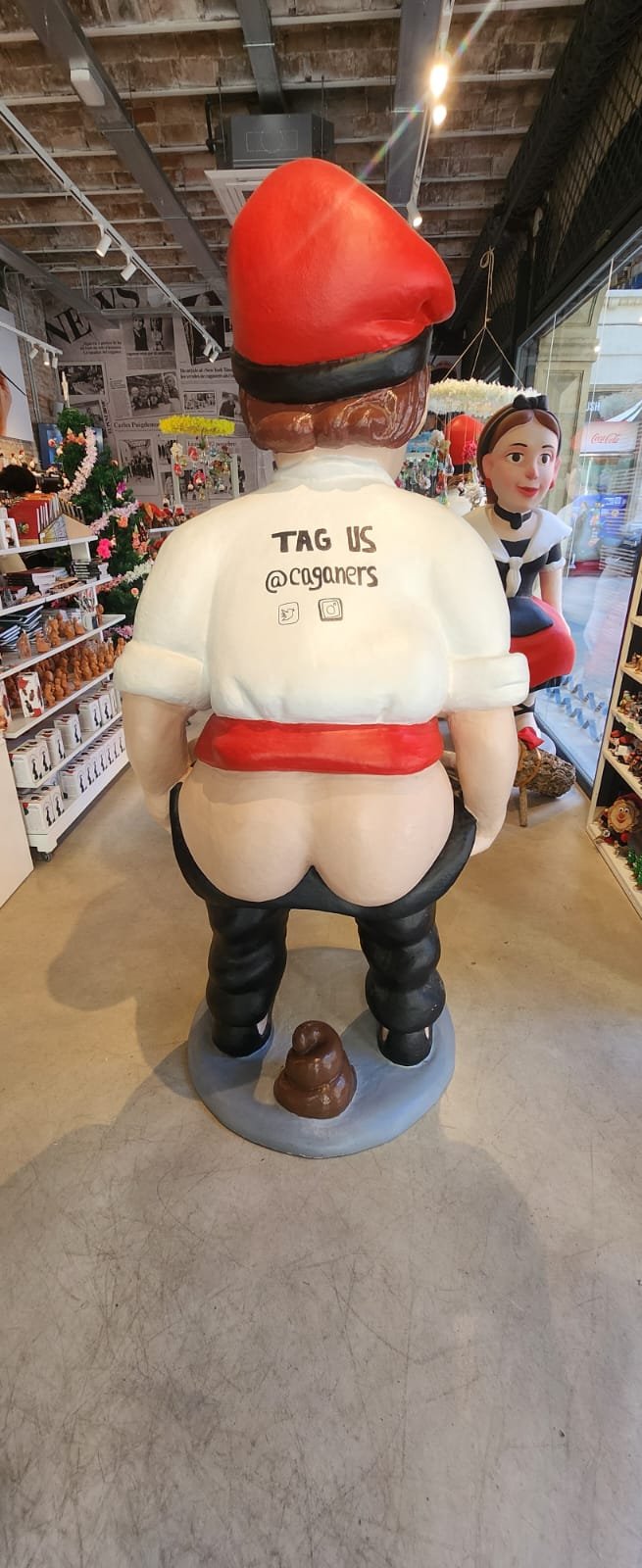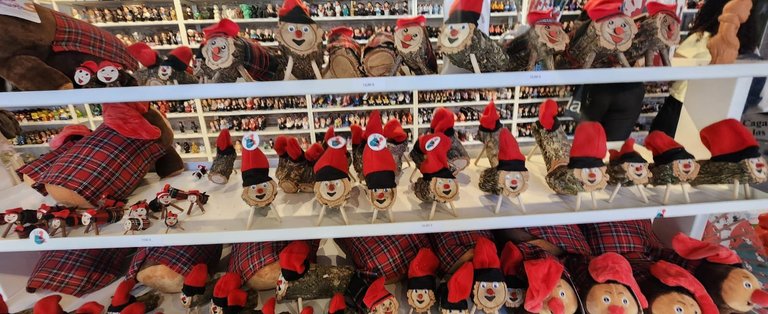Discovering the legend of the Cagatió was a fascinating experience that revealed to me a unique and endearing Christmas tradition in Spain, specifically in the region of Catalonia. This legend, loaded with symbolism and joy, replaces in many Catalan homes the universal figure of Santa Claus, and its peculiarity lies in its deep-rooted character in local customs and folklore.

My first encounter with the history of the Cagatió occurred during a visit to Barcelona. As I strolled through the decorated streets and immersed myself in the festive atmosphere, I noticed a small wooden figure in almost every home and shop window: a smiling log wearing a red barretina, typical Catalan cap, covered with a blanket. Curious to understand more about this figure, I asked my local friends about its meaning. They enthusiastically told me the endearing legend of the Cagatió.

The Cagatió, also known simply as Tió, is a Christmas tree trunk that Catalan children take great care of during the weeks leading up to Christmas. The tradition begins on December 8, the day of the Immaculate Conception. Families bring the log home and place it in a special place, covering it with a blanket to protect it from the cold and "feeding" it with sweets and small gifts every night. This practice of "feeding" the Cagatió symbolizes generosity and the spirit of Christmas, teaching the children values of care and attention.

The most awaited night comes on December 24th, when the ritual of the "caga Tió" takes place. On this night, the children, armed with sticks, sing a joyful song while hitting the trunk covered with the blanket. The most popular song goes:
"Caga Tió,
tió de Nadal,
no caguis arengades,
que són massa salades,
caga torrons,
que són més bons!"
The song, which translates as "Caga Tió, Tió de Navidad, no cagues arenques, que son demasiado salados, caga turrones, que son más ricos", reflects the wait for the sweets and gifts that are hidden under the blanket. At the end of the song, the children lift the blanket to discover the gifts that the Tió "has shat". This part of the tradition, which might seem strange at first glance, is full of laughter and joy, marking the climax of the celebration.

The legend of the Cagatió has its roots in ancient pagan traditions related to the winter solstice and the renewal of nature. The log, symbol of the wood that burns in the fireplace and provides warmth, also represents fertility and abundance. Over time, this tradition merged with the Christian celebrations of Christmas, adapting and evolving into what we know today as the Cagatió.
What touched me most about this tradition is how it unites families and the community in an act of love and generosity. Unlike the solitary figure of Santa Claus, who descends down the chimney to leave gifts, the Cagatió requires the active participation of everyone. From the preparations and care of the log to the singing and baton twirling, each stage of the tradition is designed to foster togetherness and joint participation.

In addition, the Cagatió is a perfect example of how local traditions can enrich our understanding of Christmas. While Santa Claus has become a global symbol, stories like the Cagatió remind us of the cultural diversity and richness of local customs that exist in different parts of the world. These traditions, while less known internationally, are equally valuable and provide a unique perspective on the meaning of the Christmas celebration.

My discovery of the legend of the Cagatió not only allowed me to learn about a unique and endearing tradition from Catalonia, but also made me reflect on the importance of local customs and how they can add depth and variety to our global celebrations. The story of the Cagatió is a testament to the Christmas spirit of generosity, togetherness and shared joy that is still alive and strong in the heart of Catalonia.
Spanish version
Descubrir la leyenda del Cagatió fue una experiencia fascinante que me reveló una tradición navideña única y entrañable en España, específicamente en la región de Cataluña. Esta leyenda, cargada de simbolismo y alegría, reemplaza en muchos hogares catalanes a la figura universal de Papá Noel, y su peculiaridad reside en su carácter profundamente arraigado en las costumbres y folclore locales.

Mi primer encuentro con la historia del Cagatió ocurrió durante una visita a Barcelona. Al pasear por las calles decoradas y sumergirme en el ambiente festivo, noté una pequeña figura de madera en casi todos los hogares y escaparates: un tronco sonriente con una barretina roja, típica gorra catalana, cubierto con una manta. Curioso por entender más sobre esta figura, pregunté a mis amigos locales sobre su significado. Así, me relataron con entusiasmo la entrañable leyenda del Cagatió.

El Cagatió, también conocido simplemente como Tió, es un tronco navideño que los niños catalanes cuidan con mucho esmero durante las semanas previas a la Navidad. La tradición comienza el 8 de diciembre, el día de la Inmaculada Concepción. Las familias traen el tronco a casa y lo colocan en un lugar especial, cubriéndolo con una manta para protegerlo del frío y "alimentándolo" con dulces y pequeños regalos cada noche. Esta práctica de "alimentar" al Cagatió simboliza la generosidad y el espíritu de la Navidad, enseñando a los niños valores de cuidado y atención.

La noche más esperada llega el 24 de diciembre, cuando se lleva a cabo el ritual del "caga Tió". En esta noche, los niños, armados con bastones, cantan una alegre canción mientras golpean el tronco cubierto con la manta. La canción más popular dice:
"Caga Tió,
tió de Nadal,
no caguis arengades,
que són massa salades,
caga torrons,
que són més bons!"
La canción, que se traduce como "Caga Tió, Tió de Navidad, no cagues arenques, que son demasiado salados, caga turrones, que son más ricos", refleja la espera de los dulces y regalos que se esconden bajo la manta. Al final de la canción, los niños levantan la manta para descubrir los regalos que el Tió "ha cagado". Esta parte de la tradición, que podría parecer extraña a primera vista, está llena de risas y alegría, marcando el punto culminante de la celebración.

La leyenda del Cagatió tiene sus raíces en antiguas tradiciones paganas relacionadas con el solsticio de invierno y la renovación de la naturaleza. El tronco, símbolo de la madera que arde en la chimenea y proporciona calor, también representa la fertilidad y la abundancia. Con el paso del tiempo, esta tradición se fusionó con las celebraciones cristianas de la Navidad, adaptándose y evolucionando hasta convertirse en lo que hoy conocemos como el Cagatió.
Lo que más me conmovió de esta tradición es cómo une a las familias y a la comunidad en un acto de amor y generosidad. A diferencia de la figura solitaria de Papá Noel, que desciende por la chimenea para dejar regalos, el Cagatió requiere la participación activa de todos. Desde los preparativos y el cuidado del tronco hasta la canción y los golpes con el bastón, cada etapa de la tradición está diseñada para fomentar la unión y la participación conjunta.

Además, el Cagatió es un ejemplo perfecto de cómo las tradiciones locales pueden enriquecer nuestra comprensión de la Navidad. Mientras que Papá Noel se ha convertido en un símbolo global, historias como la del Cagatió nos recuerdan la diversidad cultural y la riqueza de las costumbres locales que existen en diferentes partes del mundo. Estas tradiciones, aunque menos conocidas internacionalmente, son igualmente valiosas y aportan una perspectiva única sobre el significado de la celebración navideña.

Mi descubrimiento de la leyenda del Cagatió no solo me permitió conocer una tradición única y entrañable de Cataluña, sino que también me hizo reflexionar sobre la importancia de las costumbres locales y cómo estas pueden añadir profundidad y variedad a nuestras celebraciones globales. La historia del Cagatió es un testimonio del espíritu navideño de generosidad, unión y alegría compartida, que sigue vivo y fuerte en el corazón de Cataluña.
